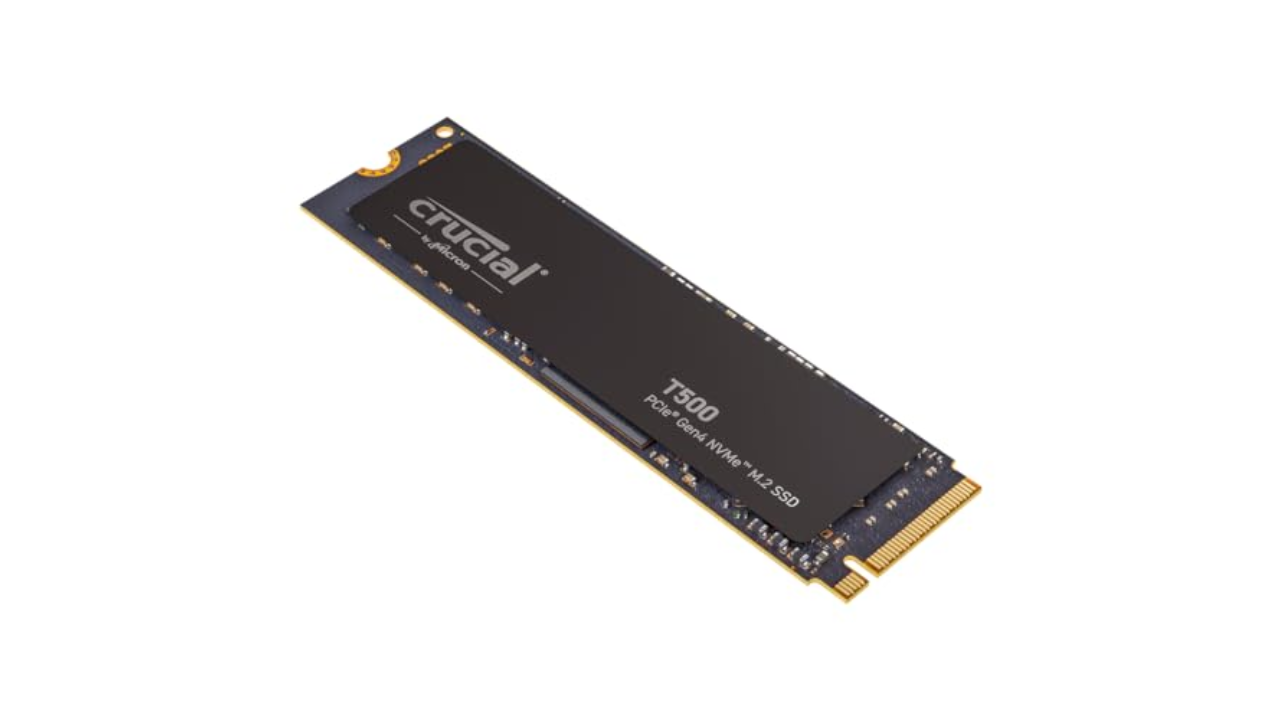When Sony released the PlayStation 5 in 2020, it wasn’t possible to expand the console’s storage. Thankfully, that changed with a software update that the company pushed out less than a year later. And with how big some game installs have become in recent years, it’s a good thing, too: the PS5’s built-in 667GB of space may have been good enough in the system’s first year, but in 2024, the default drive is absolutely limiting.
The good news is a standard PCIe Gen4 x4 M.2 NVMe SSD can solve all of your PS5 storage woes. If that mess of acronyms has you recoiling, don’t worry: you’ll see that it’s not all that complicated. And if all you want to know is what the best PS5 SSDs are, they’re right at the top.
Read more: These are the best SSDs in 2024
Best PS5 SSDs in 2024
Capacity: Up to 8TB | Sequential read performance: 7,100MB/s | Sequential write performance: 6,800MB/s | Connection: M.2
The Corsair MP600 Pro LPX makes it to the top of our list for the best PS5 SSD for being the complete package. It’s fast, offering excellent performance and read speeds of up to 7,100MB/s. It also comes with a pre-installed heatsink and a five-year warranty. Best of all, the MP600 is affordable. After launching at $190, you can routinely find the 1TB variant on sale for less than $100, while the 2TB model will set you back between $160 and $210. It’s not the fastest NVMe on this list, but as far as no-fuss options go, it’s hard to beat the MP600.
- Built-in heatsink
- Affordable
- Not the fastest Gen4 model
Capacity: Up to 4TB | Read performance: 7,300MB/s | Write performance: 6,800 MB/s | Connection: M.2
If you want to save a bit of money by installing your own heatsink, the Crucial T500 is a great option. With read speeds of up to 7,300MB/s, it more than meets Sony’s technical requirements, and you can frequently find the 1TB model for as little as $60 when it’s on sale. Crucial also offers a version with a heatsink, so it’s worth adding both the Corsair MP600 and Crucial T500 to a price watch list and buying whichever model is cheaper when you’re ready to upgrade your PS5.
- Fast
- Available with or without heatsink
Capacity: Up to 8TB | Sequential read performance: 7,000MB/s | Sequential write performance: 6,600MB/s | Connection: M.2
Of all the SSDs on this list, the Sabrent Rocket 4 Plus is the most interesting. It comes with a unique heatsink that you install in place of the storage expansion slot’s metal cover. Sabrent claims this design improves cooling performance. Expect to pay more than you would for a model with a more generic heatsink, with the 1TB variant coming in at $130 and the 2TB model costing between $230 and $280.
- PS5-specific heatsink design
- Not as fast as other options
- Expensive relative to other drives
Capacity: Up to 4TB | Read performance: 1,050MB/s | Write performance: 1,000MB/s | Connection: USB 3.0
As I explain below, you can’t run PS5 games from an external drive — but you can use one to store any games you aren’t playing at the moment (and that includes older PS4 games). One of my favorite portable drives is the Samsung T7. It can write files at a speedy 1,000 MB/s. If you plan to use the drive exclusively for at-home use, you can save money by buying the standard model instead of the Shield variant, which has a rugged exterior for extra protection for those who are always on the go. I’ve been using T7 drives to store my photos, music and games for years, and I have yet to see one fail me. The latest model, the Samsung T9, boasts read/write speeds of up to 2,000MB/s.
- Affordable
- Reliable
- Rugged variant available
- Can’t play PS5 games from external drive
How we test PS5 SSDs
After helping to maintain this guide for the past two years, I’ve tested most of the SSDs recommended on this list, either for PS5 or computer use. I also bought and used our top pick in my own PS5.
How much PS5 storage do I need?
The PlayStation 5 will accept internal drives with between 250GB and 8TB of storage capacity. If you already own a PS5, chances are you have a reasonable idea of how much storage you need for your game library. If you’re buying an SSD with a new PS5, or buying for someone else, it’s more difficult to tell what you might need for a high-performance experience.
PS5 games are a little smaller on average than their PS4 equivalents, typically taking up between 30GB and 100GB, with some notable (and very popular) exceptions. If you’re a fan of the Call of Duty series, installing Modern Warfare III and Warzone 2.0 will require about 250GB. In other words, a full Call of Duty install will take up more than one-third of the PS5’s internal storage. If you’re not a CoD fan, though, chances are you’ll be good to store between six to 10 games on your PS5 internally before running into problems.
You also need to consider your internet speed. If you live in an area with slow broadband, the “you can just download it again” rationale doesn’t really work. At my old home, a 100GB download took me around eight hours, during which time it was difficult to simultaneously watch Twitch or, say, publish articles about upgrading PS5 SSDs. Keeping games around on the off-chance you’ll want to play them at some point makes sense.
Off the bat, there’s basically no point in going for a 250GB PS5 SSD. Economically, 250GB drives aren’t that much cheaper than 500GB ones — and practically, that really isn’t a lot of space for modern games to live on. 500GB drives, coming in at around $60 to $80, are a decent option, but the sweet spot for most is to opt for a high-capacity 1TB drive, which should run you about $100. That will more than double the PS5 storage you have available for games without breaking the bank.
If you have the money, 2TB drives sometimes offer marginal savings per gigabyte, and can often be found when other models are out of stock. Unless you’re rolling in cash and want to flex, 4TB and 8TB models should mostly be avoided, as you’ll end up paying more per gigabyte than you would with a 1TB or 2TB drive.
While the 825GB PS5 only provides 667GB of storage, that’s largely due to storage being reserved for the operating system and caching. If you install a 1TB PS5 SSD, you’ll have, within a margin of error, 1TB of storage available for games.
Lastly, all of our recommendations will work with the PS5 Slim and PS5 Pro.
Can you play PS5 games on an external SSD?
External hard drives tend to cost less than internal SSD counterparts (and there’s a good chance you might own one already). But unfortunately, there are restrictions on what you can do with them. An external SSD connects to your PS5 via USB, and is only suitable for playing PlayStation 4 games, or storing PS5 titles. This is useful if you have anything but the best high-speed internet — it’s faster to move a PS5 game out of “cold storage” on an external drive than it is to re-download it — or want to keep your PS4 library on hand.
Due to the limitations here, you don’t need the highest-performing model, although you should opt for SSDs over HDDs for improved transfer speeds and load times. Any basic portable drive from a reputable brand will do, with the Crucial X9 Pro and Samsung T5 being options we’ve tried and can recommend.
Which SSD cards are compatible with the PS5?
The official answer to this question is an “M.2 Socket 3 (Key M) Gen4 x4 NVME SSD.” But even within that seemingly specific description, there are still more things to consider. The main requirements Sony has laid out for compatibility come down to speed, cooling and physical dimensions.
For speed, Sony says drives should be able to handle sequential reads at 5,500MB/s. Early testing showed that the PS5 would accept drives as slow as 4,800MB/s, and that games that tap into the SSD regularly — such as Ratchet & Clank: Rift Apart — would cause no issues. Pretty much the only thing the PS5 will outright reject is one that doesn’t match the Gen4 x4 spec.
In our opinion, though, using a drive slower than the specification is a risk that, if you don’t already have that drive lying around, is not worth taking. Just because we haven’t found issues yet doesn’t mean there won’t be games that could be problematic in the future. The price difference between these marginally slower Gen4 drives and the ones that meet Sony’s spec is not huge, and you might as well cover all your bases.
Slightly more complicated than speed is cooling and size. Most new SSDs are going to be just fine; the PS5 can fit 22mm-wide SSDs of virtually any length (30mm, 40mm, 60mm, 80mm or 110mm, to be precise). The vast majority of drives you find will be 22mm wide and 80mm long, so no problem there.
It should be noted that the system can fit a 25mm-wide drive, but that width must include the cooling solution. Speaking of, Sony says SSDs require “effective heat dissipation with a cooling structure, such as a heatsink.” The maximum height supported by Sony’s slot is 11.25mm, of which only 2.45mm can be “below” the drive.
This previously meant some of the most popular heatsinked Gen4 SSDs, including Corsair’s MP600 Pro LP, would not fit within the PS5’s storage expansion slot. Since Engadget first published this guide in 2021, most NVMe makers, including Samsung, have come out with PlayStation-specific models that meet those requirements. That said, if you want to save some money, bare drives are often cheaper, and it’s trivial to find a cooling solution that will work for the PS5.
The only component in an NVMe SSD that really requires cooling is the controller, which without a heatsink will happily sear a (very small) steak. Most SSDs have chips on only one side, but even on double-sided SSDs, the controller is likely to be on top, as manufacturers know it needs to be positioned there to better dissipate heat.
So, head to your PC component seller of choice, and pick up basically anything that meets the recommended dimensions. A good search term is “laptop NVME heatsink,” as these will be designed to fit in the confines of gaming laptops, which are even more restrictive than a PS5. They’re also typically cheaper than the ones labeled as “PS5 heatsinks.”
One recommendation is this $6 copper heatsink, which attaches to the PS5 SSD with sticky thermal interface material. It works just fine, and in performing stress tests on a PC, we couldn’t find anything metal that didn’t keep temperatures under control. When you’re searching, just make sure the solution you go for measures no more than 25mm wide or 8mm tall (including the thermal interface material) and has a simple method of installation that’s not going to cause any headaches.
One last thing. When shopping for a PS5 NVMe, there’s no reason to buy a Gen5 model over a more affordable Gen4 model. As things stand, Sony’s console can’t take advantage of the new standard, and though Gen5 drives are backward compatible, they’re more expensive than their Gen4 counterparts. Just buy the fastest and highest-capacity Gen4 model you can afford.
How to install an SSD into your PS5
Before attempting to add more storage via a PS5 SSD, ensure that you have Sony’s latest software installed. Once you’re up-to-date, installation of a PS5 SSD is fairly straightforward. Sony recommends a #1 Phillips or crosshead screwdriver, but this isn’t rocket science. Any crossed screwdriver of a similar size will do fine.
1. Power everything down to remove the stand
Before attempting to add more storage via an NVMe, ensure that you have Sony’s latest software installed. Once you’re up-to-date, installation of a PS5 SSD is fairly straightforward. Sony recommends a #1 Phillips or crosshead screwdriver, but this isn’t rocket science. Any crossed screwdriver of a similar size will do fine.
Begin by powering down your PS5, unplugging everything, removing the stand and flipping it over to its underside. If you have a launch PS5, that’s the side with the disc drive; if you have the launch Digital Edition, it’s the side without the PlayStation logo cutout.
Sony has a video guide to popping off the outside cover here, but the gist is you gently lift up the opposing corners and slide the panel toward the flat end of the console. There’s a knack to this, and it requires very little effort or strength. If you’re not getting it, rather than force things, readjust your grip and try again.
2. Access the drive bay
Once you’ve got everything open, you’ll see a rectangular piece of metal with a screw holding it in place. Remove that screw and you’ll be able to access the drive bay.
You’ll see five holes inside, each numbered corresponding to the standard SSD drive lengths I mentioned earlier. The one numbered 110 will have a metal insert and screw inside. You need to unscrew the screw with a screwdriver, and then unscrew the insert with your fingers and move it to the relevant hole. For most drives, it’s going to be 80.
3. Slot in the SSD
Then take your SSD and slot it in. The slot is at the edge closest to the number “30,” and SSDs are keyed to only fit in one way, so again, no force is required. If it’s not sliding in, don’t force it. You’ll notice the SSD doesn’t sit flat. That’s fine and is as intended.
4. Screw the drive bay back in
Once the SSD is seated, take the screw you removed from the insert, line it up with the little notch at the end of your SSD, and push down so it meets the insert. Give the screw a few turns — it doesn’t need to be very tight — and you’re done.
Replace the metal cover and screw it down, and then slide the plastic outer shell back on.
When you first turn on the PS5, it’ll prompt you to format the drive. Do that! You have now successfully expanded your console’s storage, and can set about downloading and moving games to it.
We’ll be updating this guide as more SSDs come to market and onto our test bench, so feel free to bookmark it for when you need it.
Trending Products

Cooler Master MasterBox Q300L Micro-ATX Tower with Magnetic Design Dust Filter, Transparent Acrylic Side Panel…

ASUS TUF Gaming GT301 ZAKU II Edition ATX mid-Tower Compact case with Tempered Glass Side Panel, Honeycomb Front Panel…

ASUS TUF Gaming GT501 Mid-Tower Computer Case for up to EATX Motherboards with USB 3.0 Front Panel Cases GT501/GRY/WITH…

be quiet! Pure Base 500DX Black, Mid Tower ATX case, ARGB, 3 pre-installed Pure Wings 2, BGW37, tempered glass window

ASUS ROG Strix Helios GX601 White Edition RGB Mid-Tower Computer Case for ATX/EATX Motherboards with tempered glass…











